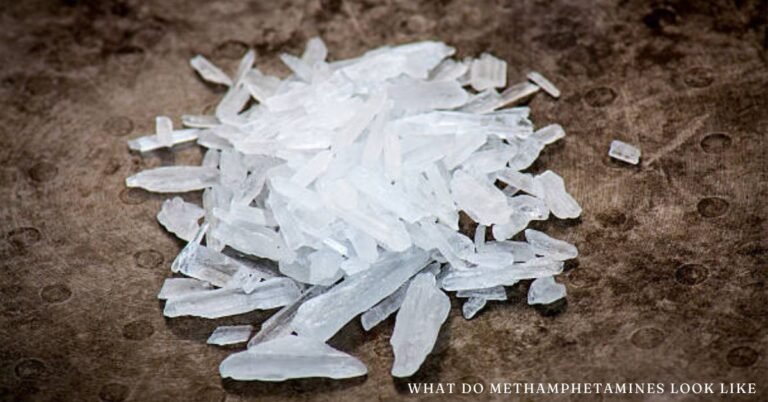Introduction: Understanding “What Do Methamphetamines Look Like?”
Methamphetamine, commonly referred to as “meth,” is a powerful and highly addictive stimulant that affects the central nervous system. As one of the most abused illicit substances, meth is often associated with devastating health consequences and widespread social issues. Given its various forms, identifying methamphetamine is crucial for law enforcement, medical professionals, and concerned individuals.
Methamphetamine can appear in different textures, colors, and compositions, depending on how it is manufactured and distributed. From crystalline formations to powdered substances, meth is often altered to increase potency or disguise its presence. This article provides a detailed examination of what methamphetamines look like, the various street names they go by, and how different types of meth are processed and consumed. By the end of this guide, you will have a clearer understanding of how to recognize methamphetamine in its different forms, helping to promote awareness and prevention.
Crystal Meth: The Most Recognizable Form of Methamphetamine
Crystal meth, or “ice,” is one of the most common and visually distinctive forms of methamphetamine. This type is known for its glass-like, crystalline appearance, which resembles small shards of broken ice or rock salt. The transparency of crystal meth can vary from clear to shades of white, blue, or even pink, depending on impurities introduced during manufacturing.
Crystal meth is typically produced using a combination of over-the-counter decongestants, such as pseudoephedrine, and a variety of toxic chemicals, including ammonia and lithium. Due to this crude production process, the resulting crystals may have a slightly greasy or powdery texture when handled. The drug is most commonly ingested by smoking it in glass pipes, snorting, injecting, or swallowing, with smoking being the preferred method among users because it delivers an intense and rapid high.
On the street, crystal meth goes by several names, including “ice,” “glass,” “shards,” and “crystal.” It is widely distributed in small plastic baggies or foil packets, and it is often sold by weight. Understanding the physical characteristics of crystal meth is crucial, as its use can lead to severe addiction, health deterioration, and fatal overdoses. Additionally, recognizing this form of meth can help identify users or potential meth labs in your community.
Powdered Meth: A Less Distinct but Equally Dangerous Variant
Powdered meth, also known as “speed” or “crank,” is another common form of methamphetamine. Unlike crystal meth, which has a solid and shard-like structure, powdered meth appears as a fine, off-white or light brown powder. This variation is often less potent than crystal meth but is still highly addictive and dangerous.
One of the reasons powdered meth is widely available is its ease of production and transportation. The powder can be snorted, injected, or even mixed into beverages for ingestion. Because it lacks the distinct crystalline appearance of “ice,” powdered meth can sometimes be mistaken for other stimulant drugs like cocaine. However, meth has a slightly coarser texture and may have a chemical odor similar to ammonia or acetone.
Street dealers frequently cut powdered meth with other substances to increase profits, which can alter its appearance. Additives such as baking soda, sugar, or caffeine can change the texture and color, making it difficult to identify pure meth. Recognizing powdered meth is essential, especially for those in law enforcement or healthcare settings, as it is a commonly trafficked form of the drug.
Liquid Methamphetamine: A Covert and Evolving Form
Liquid methamphetamine is a less common but increasingly prevalent form of meth used for smuggling and concealment. It is typically a clear or yellowish liquid, often stored in bottles, vials, or even everyday household containers like soda bottles or juice cartons. Law enforcement agencies have reported cases of liquid meth being disguised as soft drinks to evade detection during transportation.
This form of meth is created by dissolving the crystalline or powdered form in a solvent, making it easier to transport across borders without attracting suspicion. Upon reaching its destination, liquid meth is often converted back into crystal form through chemical processes. However, some users inject liquid meth directly into their veins, which can lead to rapid and severe addiction.
Because liquid meth lacks a distinct solid appearance, it is one of the hardest forms to identify. Law enforcement officials rely on chemical testing to confirm its presence, as it can be easily mistaken for other liquid substances. Despite its inconspicuous nature, liquid meth is just as potent and dangerous as other forms, posing severe health risks to users.
Pill and Tablet Form: Prescription Methamphetamines and Illicit Counterfeits
Not all methamphetamine is produced and distributed illegally. Some prescription medications, such as Desoxyn, contain methamphetamine and are used to treat ADHD and obesity under strict medical supervision. These pharmaceutical-grade methamphetamines are typically produced in small, white or blue tablets and come with clear labeling from pharmaceutical companies.
However, illegal pill versions of methamphetamine have surfaced in the black market, often pressed into counterfeit tablets resembling popular prescription drugs like Adderall or MDMA. These illicit pills are mass-produced in unregulated labs and can contain lethal doses of methamphetamine, fentanyl, or other dangerous substances. Users who believe they are taking legitimate prescription stimulants may unknowingly consume a potent and life-threatening mix of chemicals.
Counterfeit meth pills are usually sold in bright colors, mimicking the design of legitimate pharmaceutical pills. They may also have imprinted logos or markings to deceive buyers. Because they are often consumed orally, they appeal to younger users who may be wary of snorting or injecting drugs. Recognizing fake meth pills is crucial, as their unpredictable composition makes them particularly hazardous.
Infographic: Different Forms of Methamphetamine
To enhance user understanding, here’s a comparison chart summarizing the physical characteristics of different methamphetamine forms:
| Form | Appearance | Common Street Names | Consumption Methods |
|---|---|---|---|
| Crystal Meth | Clear, white, or blue glass-like shards | Ice, Glass, Shards | Smoking, injecting, snorting |
| Powdered Meth | Off-white or brown powder | Speed, Crank | Snorting, injecting, ingesting |
| Liquid Meth | Clear or yellowish liquid | Liquid Ice | Injecting, conversion to crystal |
| Pill/Tablet Meth | Small, round, colored tablets | Counterfeit Adderall, Yaba | Oral consumption |
Conclusion: The Importance of Recognizing Methamphetamine
Understanding what methamphetamines look like is essential for raising awareness, preventing drug abuse, and assisting those who may be struggling with addiction. Whether in its crystal, powder, liquid, or pill form, methamphetamine remains a highly addictive and destructive drug. By learning how to identify meth in its various forms, individuals can take proactive steps to educate others, report suspicious activity, and contribute to community safety.
If you suspect someone is using methamphetamine, it is important to seek professional help. Many organizations provide support for addiction recovery, offering medical and psychological assistance to those in need. Awareness and education remain the most powerful tools in combating the spread of methamphetamine abuse, ensuring a safer and healthier society for all.
FAQs About What Do Methamphetamines Look Like
1. What do methamphetamines smell like?
Methamphetamines often have a strong, chemical odor resembling ammonia, acetone, or even burnt plastic. This smell can be more pronounced in low-quality or homemade meth, where impure manufacturing processes leave behind residual chemicals.
2. How can I tell the difference between meth and other drugs like cocaine?
While both substances can appear as a white powder, meth tends to have a coarser, crystalline texture, whereas cocaine is finer and more powdery. Additionally, meth may have a slight chemical odor, while cocaine typically does not.
3. What Do Methamphetamines look like when it burns?
When smoked, meth produces a thick, white vapor and can leave behind a brownish or yellow residue in pipes. The residue hardens after cooling and can be re-smoked by users.
4. Can methamphetamine be colorless?
Yes, meth can be colorless in its liquid form, making it difficult to detect without chemical testing. Some high-purity crystal meth can also appear nearly transparent.
5. How is liquid meth different from crystal meth?
Liquid meth is a dissolved form of the drug, often used for smuggling or intravenous injection. Once transported, it is frequently converted back into crystal form. Despite its different state, liquid meth is just as potent and dangerous as crystal meth.

